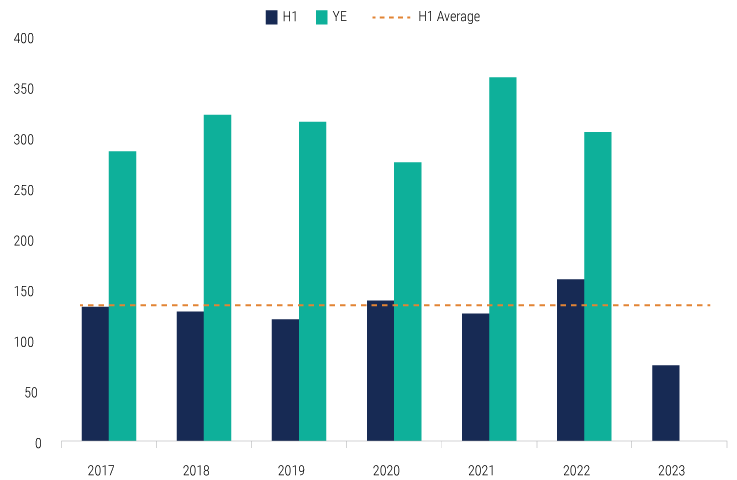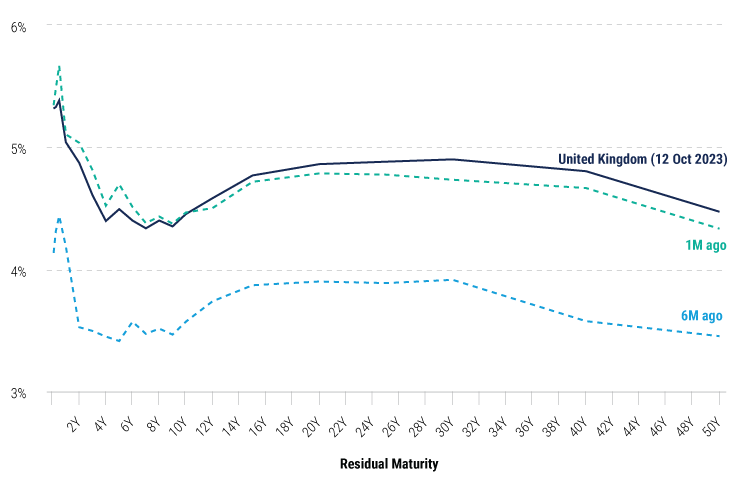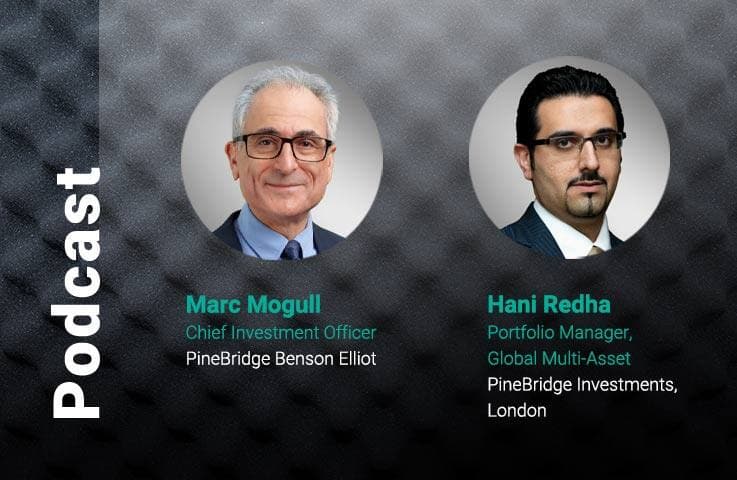Countdown to the Buyer’s Market in European Commercial Real Estate

The silence in European commercial real estate (CRE) has been deafening. Transaction volumes, the surest sign of an active, healthy market, have quieted to a whisper, down to half their average for the past half dozen years.1 As interest rates have climbed and higher bond yields and more attractive equity valuations lured investors to greener pastures, would-be sellers and buyers of European CRE have locked into an uneasy standoff. For every opportunistic manager probing for weakness and a potential steal, there is an aspiring exiter afraid of selling too low. Across this divide, hope that the next year brings firming demand and a more inviting off-ramp vies with relish over what happens to prices if it doesn’t. Which side will blink first?
European Real Estate Investment Volumes Have Dropped Markedly
Investment Volumes (bil. €)

Source: CBRE as of 30 September 2023.
Marc Mogull, chairman of PineBridge Benson Elliot, doesn’t pretend to have a crystal ball. Through his decades as a market participant and industry advisor he has, however, developed a honed perspective on how the various capital structures underlying the CRE system may operate during times of transition and stress. Based on that, he’s formulated a view on how he sees the next year or so playing out. Spoiler alert: It doesn’t involve the real estate version of a “soft landing.”
Mogull’s view is less a commentary on aspiring sellers’ staying power in the current staring contest (which, he suggests, they might sustain for some time if left to their own devices), but rather on the degree to which they’re likely to be compelled to capitulate by lenders and other behind-the-scenes powers as other financial dominoes fall into place.
Once that happens, Mogull says, the distress across parts of the European CRE market could be significant and (relatively) long-lived. While few participants will be completely spared, this inflection point is expected to create a distinct opportunity for those with the capital to take advantage. Timing any market, let alone one as illiquid and opaque as CRE, is never easy. But the coming reckoning is at least one in which decisiveness leavened by a certain amount of patience and pickiness should be rewarded. As Mogull says, there’s a “very real prospect it won’t be a ‘blink and you’ll miss it’ affair.’”
Early this year, Mogull laid out his reasons for why 2023 could a buyer’s market—for those willing to wait. He noted at the time that he thought it was unreasonable to expect a determined upswing in product hitting the market until summer gave way to autumn. Now that the leaves are turning and the air is getting a bit nippier across Europe, he shares further insight on how he sees events unfolding.
T-minus one year: The time it will take for the market to improve
It’s hard to find property optimists right now. While contrarians might argue that makes it the perfect time to start establishing positions, it also suggests, says Mogull, “there are a lot of minds that need to change before we see any meaningful market recovery.”
More than anything, he says, the European CRE market suffers a liquidity problem. Transaction volumes this low become a self-perpetuating cycle. The absence of transactions means that managers don’t have the proceeds from sales to fund new acquisitions. The lack of price discovery keeps valuations in investors’ portfolios artificially high, inflating their allocation to real estate, making it even harder for them to think about adding to exposures. It’s really a chicken-egg situation. Transactions can’t meaningfully pick up nor faith in the sector become restored until core investors see evidence of broad transactional activity at or above listed valuations. … which can’t happen without more transactions(!).
The good news is that once participants start to re-engage, “they’ll move as a herd,” Mogull says. Bid-ask spreads will likely narrow fast as more investors fear missing the upturn, driving up transaction volumes. It’s the “bandwagon effect” that helped earn behavioral scientist Richard Thaler the Nobel Prize in Economics. The question is, how long could it take for things to get rolling?
According to Mogull, there are several developments that need to occur more or less in tandem. First, as in any grieving process, current property owners need to “make peace” with sizeable portions of the retail and office markets, where a decent chunk of the liquidity needed to recapitalize the property sector is still tied up. “These two sectors are too big a component of the already invested universe for a healthy market to subsist until they’re repriced to levels that allow willing buyers and sellers to meet,” Mogull says. In one possible turn of the bandwagon wheel, fourth-quarter 2022 saw the share of global CRE transaction volumes represented by offices and retail tick up (marginally). Worth keeping an eye on.
At the same time, more buyers need to loosen their purse springs, which can only happen when more money comes back into the market. As it is, buyers’ tightfistedness is driven only in part by their skepticism (justified as it may be) over valuations. It’s also driven by an outflow of capital as investors have fled real estate in favor of other asset classes with higher liquidity and – especially in the case of short-term bonds – perceived lower risk and higher returns. “Perhaps the most important indicator I’m watching is debt yields,” Mogull says. Until six-month gilts are no longer yielding north of 5.5%, investors can’t very well be expected to plow back into the property sector.
And how long might that take? Based on the shape of the yield curve, notes Mogull, maybe not as long as people think. While others have latched on to the inverted yield curve’s recession-signaling powers (less of a concern to Mogull, given recent GDP readouts), he’s more focused on the hitch in the curve between the highest-yielding very short end and the low points some months out. If the yield curve is right, in 6 to 12 months when current short-term bond holdings expire, bond yields will be lower, and the risk-adjusted returns of real estate may start looking a little more appealing.
United Kingdom Yield Curve
United Kingdom Government Bonds

Source: World Government Bonds, Highcharts.com, as of 12 October 2023.
Of course, that would put us smack in the middle of what promises to be a fraught US and UK political season, itself hardly a balm for the real estate market. So while yes, there are early signs of movement (or at least of where to look for movement), Mogull opines, “I think it’s unrealistic to believe that the current liquidity drought in Europe’s property sector will resolve itself before we’re turning the calendar from 2024 into 2025.”
T-minus the next few months: The time it will take for lenders to call it
On the flip side, the wherewithal of aspiring exiters who continue to hold out for less-disheartening bids may change much sooner. That’s because there’s another set of actors who will play an important role in determining the path of the European CRE market, and that’s lenders.
Already, banks across Europe have been feeling antsy from higher capital charges implemented since the global financial crisis that raise the costs for banks of carrying distressed loans. Until now, the banks have responded with a surprising amount of equanimity. But Mogull cautions not to read too much into the spate of covenant waivers and short-term extensions seen so far this year. For one thing, he says, “summer is a rotten time to sell.” Plus, the loan maturity schedule is about to provide them with more impetus to act.
2024 will see a sharp spike in loan maturities, as the five-year loans from the last high-volume, pre-pandemic transactional year (2019) come due. On top of that, many of the 2015-2018 loans that benefitted from short-term extensions because of pandemic-era regulatory forgiveness programs will also, finally, be rolling over. 2
In the meantime, the rise in interest rates has left many European banks flush with profits. “They’ve had all year to get staffed and ready for distress,” Mogull says. “They’ve got modest CRE exposure compared to past cycles. The regulators aren’t discouraging action. In fact, quite the contrary.” Taken together, he expects banks to “act – decisively – at a time of their choosing.” He adds, “If anything , they’ll be mindful of the experiences from prior cycle: those who moved first saw the best outcomes.”
Pressure is also being applied quietly in other corners of the market. Open-end funds are running out of ways to stall the lengthening queue of investors clamoring for redemptions. Closed-end fund investors typically have less direct influence – unless they’re big enough – so plenty of very large managers, says Mogull, are now in discussions with their closed-end managers about clearing the books and creating distributions before they can think about committing to new raises.
In short: Product is coming. And, says Mogull, “we see it coming before the capital mobilizes to meet it.”
End of next year minus the next few months: Meet your window
Between then and then, in other words, it could get ugly. But, according to Marc Mogull, this could also create the great opportunity that awaits investors in European property over the next year or two: As the wave of forced sales hits the markets, and prices deviate from intrinsic value due to the capital dislocation (rather than intractable weaknesses in fundamentals), those with the capital – and stomach – for a distressed market will face no shortage of opportunities. Compared to the tempo of past cycles, they should also have some more months to be selective without worrying about getting run over by the bandwagon.
It would not appear that moment is upon us. Yet. But it’s likely coming soon. And those hoping to get in before the wagon rumbles by should consider preparing now: surveilling the landscape, drawing up wish lists. So, when the time does arrive, they don’t allow deliberateness to give way to doubt and the urge to wait for prices to rebound. Because, by then, the opportunity will have passed.
Disclosure
Investing involves risk, including possible loss of principal. The information presented herein is for illustrative purposes only and should not be considered reflective of any particular security, strategy, or investment product. It represents a general assessment of the markets at a specific time and is not a guarantee of future performance results or market movement. This material does not constitute investment, financial, legal, tax, or other advice; investment research or a product of any research department; an offer to sell, or the solicitation of an offer to purchase any security or interest in a fund; or a recommendation for any investment product or strategy. PineBridge Investments is not soliciting or recommending any action based on information in this document. Any opinions, projections, or forward-looking statements expressed herein are solely those of the author, may differ from the views or opinions expressed by other areas of PineBridge Investments, and are only for general informational purposes as of the date indicated. Views may be based on third-party data that has not been independently verified. PineBridge Investments does not approve of or endorse any republication of this material. You are solely responsible for deciding whether any investment product or strategy is appropriate for you based upon your investment goals, financial situation and tolerance for risk.



